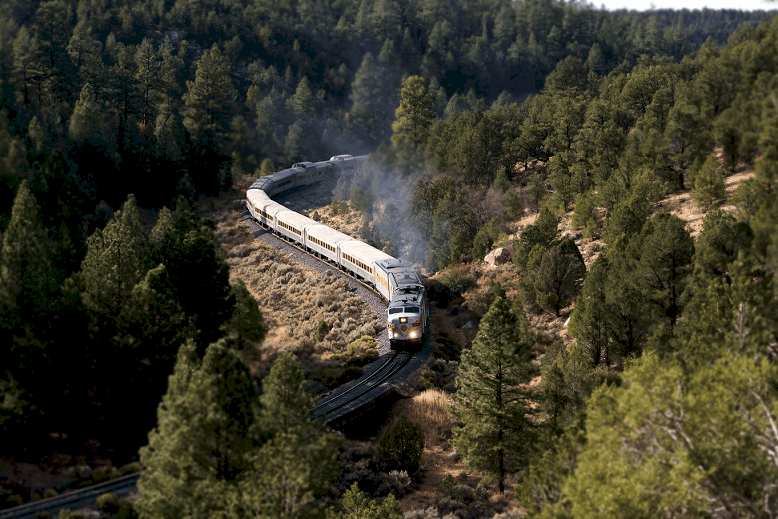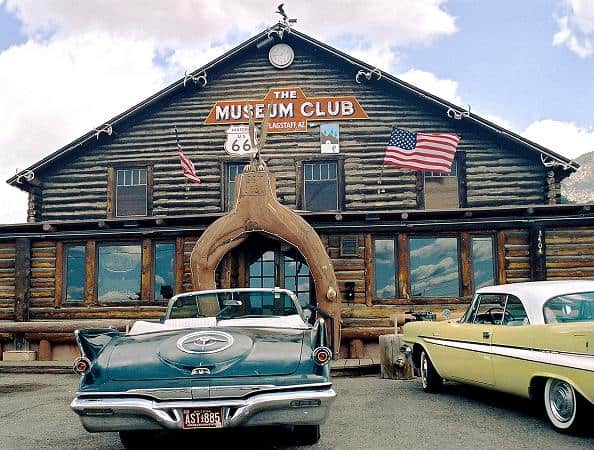 Flagstaff CVB
Flagstaff CVB
The young fellow behind the counter at Gene’s Western Wear and Shoe Hospital in Flagstaff looks and sounds just like a cowboy should. His mammoth belt buckle identifies him as a rodeo champion. He’s got the boots to match. And he knows how to custom steam the brim of a Black Bound hat so it sits just right.
In days gone by, Flagstaff was a dusty frontier town that grew because of the railroad, the livestock industry and the lumber that was cut from the neighbouring Ponderosa pine forest. Today, it’s a popular overnight stop for people making the 90-minute hop north to Grand Canyon National Park.
In Flag, they like to say: They don’t make towns like this anymore. Where else can you find a store that carries over 300 different styles of western boots, 70 types of cowboy hats, plus provides on-site professional cowboy boot repair? And how about a local distillery that produces Prickly Pear Vodka, flavoured and named after the ubiquitous prickly pear cactus, a flat-paddled plant they claim is “impossible to kill without a stick of dynamite.”
The historic downtown has been restored to save the flavour of the area: brick walkways, historic light posts and Willie or Merle blaring from every truck radio. There’s a quirky mixture of shops – outdoors gear, western wear, arts and crafts galleries. Shopkeepers lean on their wooden counters and talk with locals and visitors alike about every day things like the weather or the price of gas.
One of my favourites is a Flag landmark: the Weatherford Hotel, a commanding red brick building with wrap-around porches that was built at the turn to the 20th century, a time when gunslingers ruled the streets of the town. They say the grand old hotel is haunted. Over the decades, it has found purpose as a general store, restaurant, theatre, billiards hall and radio station. The main floor pub serves a wicked roast beef sandwich called the Flagstaff Dip, best served with extra jalapenos.
The famous Mother Road, Route 66, passes through Flagstaff. On it, the city’s iconic western honky tonk – The Museum Club – draws weekend crowds who two-step across a dance floor built around standing Ponderosa pines (branches and all). Aspiring country and western stars – including Willie Nelson, Waylon Jennings, Barbara Mandrell and Asleep at the Wheel – have stopped to play The Museum Club while chasing fame and fortune from Nashville to Las Vegas. Posted on the wall is Nelson’s signed contract for a 1968 gig – the country music legend and his band received $700 for the evening’s work. It’s easy to spot the storied Route 66 landmark: look for the huge pine log cabin with the large neon guitar-shaped sign and the parking lot full of mud-spattered pickups.
 Grand Canyon Railway
Grand Canyon Railway
All of Arizona is infused with a friendly frontier personality. You’ll find it in towns like Flagstaff and Tombstone, at dude resorts and cattle ranches, in the western-themed arts and crafts, and in the mesquite-grilled steaks the size of hubcaps.
- One of the most popular ways to travel to the Grand Canyon is aboard the vintage Grand Canyon Railway (departing from Williams). It’s a two-hour voyage in style aboard restored passenger cars. Train crew can answer questions about railway and Grand Canyon history, strolling musicians and cowboys provide a little on board entertainment and there’s even a light-hearted replaying of an Old West shoot out and train robbery. www.thetrain.com
- In Yuma, one of the signs of the Old West stands at the ruins of the Yuma Territorial Prison State Historic Park. In the mid-1800s, Yuma was a busy place, as gold seekers passed through on their way to the California gold fields. A tour of the prison ruins provides a glimpse into convict life more than a century ago. www.azstateparks.com/parks/yute
- Nicknamed “The Town Too Tough to Die,” Tombstone likes to play up its dusty image of the Wild West. Tombstone is home to one of the most notorious streets in western lore – the place where heroes and outlaws squared off at the infamous gunfight at the O.K. Corral. There’s a daily re-enactment of the shootout, stagecoach rides, jeep expeditions to ghost towns and underground mine tours. www.cityoftombstone.com
- The Wild West even lives on through the arts. Each February, the Cochise Cowboy Poetry & Music Gathering in Sierra Vista headlines leading western poets and musicians. In the old gold mining town of Wickenburg, the Desert Caballeros Western Museum holds the annual springtime Cowgirl Up! art event, celebrating the country’s best western women artists.
- One of Arizona’s hidden gems is the Highway 89-A Loop Scenic Drive, touching on some of the most photo-friendly reminders of Old West history at the historic copper mining town of Jerome. Over one billion dollars worth of copper was pulled from Jerome’s lucrative hills, but with the closing of the mines it almost became a ghost town. These days it has found new life as a hotspot for artists, musicians and writers. All with a spectacular mile-high view. www.jeromechamber.com
- Arizona’s ranch stays offer the whole spectrum, from rustic getaways on a working cattle ranch to amenity-infused luxury at guest dude ranches. Ranch stays are a popular venue for family reunions, out-of-the-box weddings and honeymoons, and small-scale corporate retreats. Activities include horseback riding, hayrides, campfire cookouts, as well as a good dose of R&R. Search “guest ranches” at www.arizonaguide.com
- In its Wild West heyday, tiny Bisbee’s streets were home to 47 rowdy saloons, mostly along a stretch known as Brewery Gulch. The mile-high town – tucked into the Mule Mountains – was once home to a thriving copper mining industry. Today, Bisbee is known for its well-preserved Victorian architecture, art galleries and crafts shops, and the historic Copper Queen Hotel. www.discoverbisbee.com


